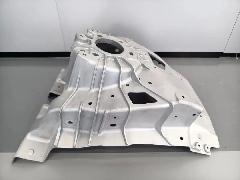Domestic Production Rate Exceeds 60%: Why Is There Still Great Potential in Reducer Shaft Machining?
【Introduction】 Precision reducer、Robot、CNC machine tool machining
Introduction: In the Era of Robot Mass Production, How Can Machine Tools Overcome the Bottleneck in Reducer Shaft Machining? / Amid the Wave of Robot Mass Production, How Can Machine Tools "Compete Head-On" in Reducer Shaft Machining?
Earlier, Elon Musk revealed that the company will launch the third-generation Optimus in the first quarter of 2026, and a production line with an annual output of one million units is also planned to be officially put into operation by the end of 2026. In addition, domestic enterprises including UBtech, DeepRobotics, Unitree Robotics, ZhiPingFang, Stardust Intelligence, Songyan Power, and Force Infinity have recently frequently secured 100-million-yuan-level or 1,000-unit-level orders for humanoid robots... Humanoid robots are moving from laboratories to production lines and daily life scenarios at an unprecedented speed, and the "gate" to mass production in this era is accelerating to open.
As the "joint core" of robots, precision reducers are essential: a single humanoid robot needs to be equipped with 26-40 high-precision reducers. Shaft parts, as the "power transmission nerves" of reducers, directly determine the motion accuracy and service life of robots. According to data from the National Bureau of Statistics, the output of robot reducers surged by 1.2 times in the first three quarters of 2025.

The key to promoting domestic reducers toward high precision and long service life lies in the manufacturing level of precision shaft parts, which in turn relies on the technical support of precision CNC machine tools.
Reducer Market Booms, Sparking Explosive Demand for CNC Machine Tools
The global stock of humanoid robots is expected to reach 300 million units by 2050, and the corresponding reducer market scale will continue to expand with the popularization of complete robots.
Data from the China Commercial Industry Research Institute shows that the market scale of China’s reducer industry was approximately 144.8 billion yuan in 2024, an increase of 4.4% year-on-year; in 2025, the market scale of China’s reducer industry will grow to 151 billion yuan.
Precision reducers used in humanoid robot scenarios mainly include harmonic reducers, RV reducers, and planetary reducers:
- Harmonic reducers can provide a transmission ratio of 30-160 and are used for high-precision movements of upper limb joints;
- RV reducers can achieve a torque output of 200-5,000 N·m and are used for heavy-load parts of lower limbs.
At present, the domestic production rate of RV reducers has exceeded 60%, and the precision service life of harmonic reducers has exceeded 200 million cycles. The Ministry of Industry and Information Technology has also proposed to promote an average annual growth of 12% in the density of manufacturing robots from 2025 to 2030. The expansion of localized production capacity will inevitably drive demand for machining equipment.

Against this backdrop, traditional machine tools can hardly meet the extreme precision requirements for machining core components of reducers. For example, the thread precision of planetary roller screws needs to be controlled within ±1 μm, while the surface roughness of harmonic reducer flexspline machining requires Ra ≤ 0.1 μm. Such demands have directly triggered the market boom of ultra-precision lathes and grinders.
How Do the "Power Nerves" of Reducers Work?
Reducers contain shaft parts such as gear shafts, crankshafts, eccentric shafts, and input/output shafts, which are key carriers for transmitting torque and ensuring motion precision. Their machining quality directly determines the motion performance and service life of robots.

Input/Output Shafts as the front and rear interfaces for power transmission, input/output shafts must meet both connection precision and load-bearing strength requirements:
- First, the coaxiality of stepped shaft diameters must be controlled, with radial runout of different shaft sections ≤ 0.015 mm;
- Second, the machining precision of spline grooves is critical: the tooth side clearance of rectangular splines must be controlled within 0.02-0.04 mm, and strict positional accuracy with the shaft diameter must be maintained;
- Third, there are perpendicularity requirements for end face threaded holes: the perpendicularity error between the axis of M8 threaded holes and the shaft end face must be ≤ 0.02 mm/100 mm. Otherwise, the assembly precision of the reducer will be affected. High-precision lathes are required to complete turning and end face machining in a single clamping.

Gear Shafts.Gear shafts integrate gears and shaft bodies into a single design, with both transmission and support functions, and are widely used in planetary reducers. As a unified reference for the gear part and shaft diameter, the coaxiality between the gear reference circle and the shaft journal must be ≤ 0.01 mm (otherwise, transmission noise will occur). The gear tooth surface requires high machining precision: the involute tooth profile error must be ≤ 0.008 mm, and the tooth surface roughness must be Ra ≤ 0.8 μm, which requires precision machining by gear grinding machines.
Crankshafts as the core of power conversion in RV reducers, crankshafts require machining of multiple different shaft journals and connecting rod journals, with the following processing requirements:
- During the machining of eccentric shaft journals, the uneven cutting force caused by clamping eccentricity is prone to induce workpiece vibration, which in turn affects surface roughness;
- The dynamic balance requirement is extremely high: the unbalance of the finished product must be controlled within 5 g·mm. Otherwise, it will cause abnormal noise during reducer operation and reduce its service life.
Eccentric Shafts
Eccentric shafts are key parts for achieving the reduction ratio of reducers, and the precision of their eccentricity directly affects transmission efficiency. They are commonly used in the cycloid wheel drive structure of RV reducers:
- The dimensional precision of eccentricity is strictly controlled, generally requiring ≤ 0.01 mm, and multiple eccentric sections must maintain a strict phase difference (e.g., 180° symmetric distribution);
- The clamping stability of the special-shaped structure must be ensured: the coaxiality requirement between the eccentric section and the reference shaft diameter is ≤ 0.008 mm, and improper clamping may easily lead to machining deformation;
- A balance between material hardness and machining efficiency must be struck: after carburizing and quenching of 20CrMnTi, the cutting resistance increases sharply, requiring machine tools to have high-power cutting and high-precision compensation capabilities.
The precision of shaft parts directly determines the performance of reducers, and the application logic of machining equipment in this process is consistent:
- Key shaft diameters must reach IT6-IT7 accuracy grades;
- The radial runout of bearing positions must not exceed 0.02 mm;
- The coaxiality of crankshafts must be controlled within 0.01 mm;
- Finally, the roughness of mating surfaces must be Ra ≤ 0.8 μm to reduce wear and extend service life.

Traditional lathes can only achieve IT8 accuracy in a single machining process and require multiple process connections. In contrast, high-end turn-mill centers can complete turning, milling, and drilling processes in a single clamping, improving coaxiality to 0.01 mm. At the same time, the application of hard turning technology requires machine tools to be equipped with CBN tools and high-precision spindles to achieve a surface quality of Ra 0.4 μm, with machining efficiency 3 times higher than traditional grinding.
How Can CNC Machine Tools Meet Precision Requirements?
Facing the diverse machining needs of reducer shaft parts, leading domestic and foreign shaft machining center brands have launched targeted solutions, covering turning centers, CNC grinders, and other equipment, providing technical support for mass production.

Yamazaki Mazak: The QRX-50MSY LC CNC Turning Center can machine features such as crankshaft threads and tapered surfaces with extremely high relative positional accuracy and complex spatial relationships, significantly improving production efficiency. The INTEGREX AG Series has the functions of gear hobbing, gear rolling, and gear milling, suitable for gear part machining, which can shorten production delivery time and achieve high-precision machining.

Tsugami Machine Tool: To meet the grinding precision requirements for high-precision shaft parts machining, the G18 Series and G350 Series precision grinders perform internal and external cylindrical grinding with an accuracy of ±0.001 mm. For example, for gear shaft machining needs, rough and finish turning are performed by Tsugami Swiss-type lathes, and gear milling is completed with 4-axis milling machines, achieving a coaxiality of ±0.025 mm and ensuring shaft part quality.

Hardinge Machine Tool: The HARDINGE P20 300U is a high-precision multi-purpose grinder. It adopts a modular design and high-precision composite machining; the machine bed layout designed through technologies such as FEA (Finite Element Analysis) has extremely high rigidity and stability. The 4-station grinding wheel head design automatically adjusts grinding parameters and grinding wheel position by real-time tracking the workpiece contour or machining path, ensuring the precision machining needs of special-shaped parts such as complex crankshafts and high-hardness materials.
Upcoming Exhibition: ITES Shenzhen Industrial Exhibition
At the ITES Shenzhen Industrial Exhibition – Metal Cutting Machine Tool Exhibition at the end of March next year, the above-mentioned enterprises will also exhibit their latest robot component machining solutions. In addition, high-end CNC machine tool enterprises such as Fanuc, Brother Machine Tool, Citizen, Takisawa, Guilin Guibei, Shuofang, Rongguang, and Fuxincheng will gather to showcase their latest products and industry solutions for robotics, medical care, aerospace, and other fields. Stay tuned!
ITES Themed Exhibition – Metal Cutting Machine Tool Exhibition: Aiming at scenarios such as crankshaft dimensional accuracy, shape accuracy, and surface roughness of parts during shaft part machining and production, it focuses on manufacturing industries such as auto parts, 3C electronics, medical care, and aerospace. It centrally displays exhibits including CNC lathes, CNC grinders, combined machine tools, and drilling machines, realizing full coverage of the manufacturing ecosystem and providing a one-stop technical docking platform for the industrial chain.
.jpg)
If you are also interested in the humanoid robot industrial chain, have innovative solutions for core part machining, and want to engage in in-depth contact with leading enterprises to explore cooperation opportunities, please scan the QR code to contact us, lock in your spot at the 2026 ITES Shenzhen Industrial Exhibition, and reserve your prime booth now!




